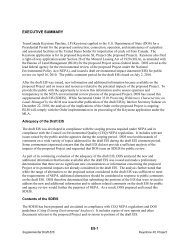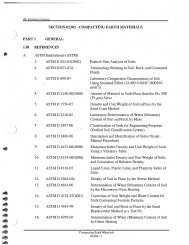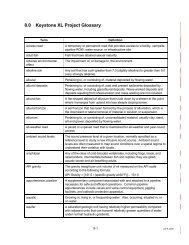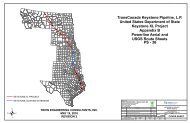2.1 Overview of the Proposed Project - Keystone XL pipeline - US ...
2.1 Overview of the Proposed Project - Keystone XL pipeline - US ...
2.1 Overview of the Proposed Project - Keystone XL pipeline - US ...
You also want an ePaper? Increase the reach of your titles
YUMPU automatically turns print PDFs into web optimized ePapers that Google loves.
Draft Supplemental Environmental Impact Statement<strong>Keystone</strong> <strong>XL</strong> <strong>Project</strong><strong>Keystone</strong> anticipates a peak workforce <strong>of</strong> approximately 5,000 to 6,000 construction personnel.These personnel would consist <strong>of</strong> <strong>Keystone</strong> employees, contractor employees, constructioninspection staff, and environmental inspection staff. All workers would be trained and certifiedfor <strong>the</strong>ir specific field <strong>of</strong> work (e.g., welders would be qualified as required by 49 CFR 195.222and PHMSA Special Condition 18).<strong>Keystone</strong>, through its construction contractors and subcontractors, would attempt to hiretemporary construction staff from <strong>the</strong> local population. Assuming that qualified personnel areavailable, approximately 10 to 15 percent (50 to 100 people per spread) could be hired from <strong>the</strong>local workforce for each spread, although this may not be possible in rural areas. This may notbe possible in more rural areas and or areas with low unemployment.Cross-country <strong>pipeline</strong> construction would typically proceed at a pace <strong>of</strong> approximately20 constructed miles per calendar month per spread. Construction would occur in <strong>the</strong> followingapproximate sequence:• Two to three weeks (14 to 21 calendar days) <strong>of</strong> work on <strong>the</strong> ROW prior to <strong>the</strong> start <strong>of</strong>production welding. Activities would include clearing, grading, stringing, and ditching.• Production welding at an average rate <strong>of</strong> 1.25 miles <strong>of</strong> pipe welded per working day over a 6day work week (over 7 calendar days), resulting in completion <strong>of</strong> an average <strong>of</strong> about7.5 miles <strong>of</strong> <strong>pipeline</strong> per week.• Seven weeks (49 calendar days) <strong>of</strong> additional work after completion <strong>of</strong> production welding.Activities would include nondestructive testing, field joint coating, pipe installation, tie-ins,backfill, ROW clean-up, hydrostatic testing, reseeding, and o<strong>the</strong>r ROW reclamation work.Those time periods and rates <strong>of</strong> progress were used as <strong>the</strong> basis for determining <strong>the</strong> duration <strong>of</strong>construction activities on <strong>the</strong> ROW presented in Table <strong>2.1</strong>-18 for various spread lengths.Construction in areas with greater congestion or higher population, in industrial areas, or in areasrequiring o<strong>the</strong>r special construction procedures could result in a slower rate <strong>of</strong> progress. Inaddition, approximately 1 month would be required for contractor mobilization before <strong>the</strong> workis started and 1 month would be required for contractor demobilization after <strong>the</strong> work is finished.<strong>2.1</strong>.10.2 Environmental Inspection<strong>Keystone</strong> would use environmental inspectors on each construction spread. The environmentalinspectors would review <strong>the</strong> proposed <strong>Project</strong> activities daily for compliance with state, federal,and local regulatory requirements and would have <strong>the</strong> authority to stop specific tasks as approvedby <strong>the</strong> chief inspector. The inspectors would also be able to order corrective action in <strong>the</strong> eventthat construction activities violate <strong>the</strong> provisions <strong>of</strong> <strong>the</strong> CMRP, landowner requirements, or anyapplicable permit requirements.<strong>2.1</strong>.11 Operations and MaintenanceThe proposed <strong>Project</strong> would be operated, maintained, monitored, and inspected in accordancewith 49 CFR 194 and 195 and o<strong>the</strong>r applicable federal and state regulations. <strong>Keystone</strong> has alsoagreed to incorporate 57 PHMSA <strong>Project</strong>-specific special conditions that address proposed<strong>Project</strong> operation, inspection, and monitoring (see Appendix B, PHMSA 57 Special Conditions).The operational requirements <strong>of</strong> 49 CFR 195 and <strong>the</strong> PHMSA <strong>Project</strong>-specific SpecialConditions related to operation <strong>of</strong> <strong>the</strong> proposed <strong>Project</strong> (Appendix B, PHMSA 57 Special<strong>Project</strong> Description <strong>2.1</strong>-64 March 2013











